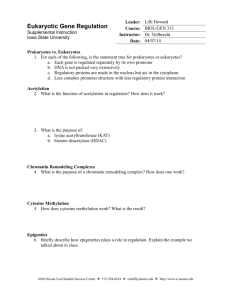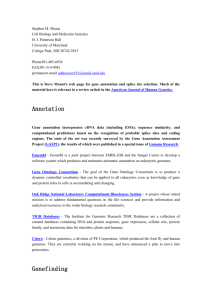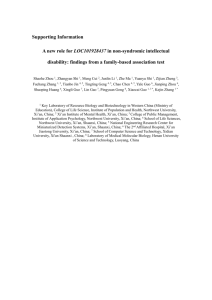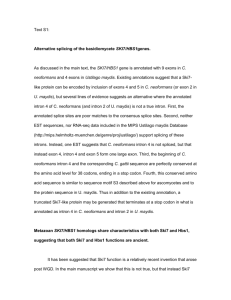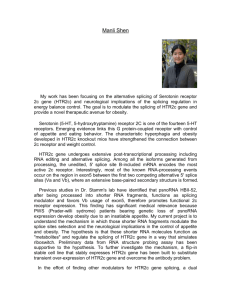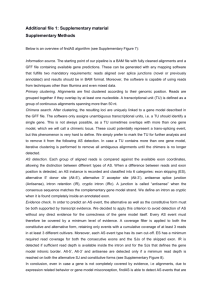Tools for Nucleic Acid Sequence Analysis
advertisement
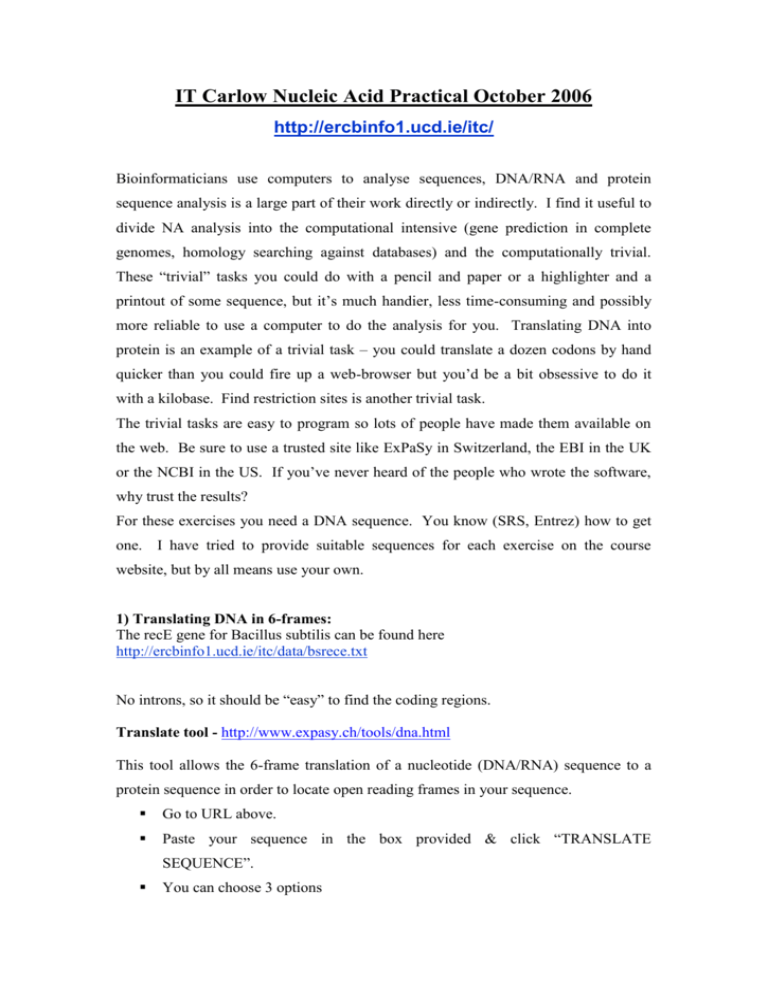
IT Carlow Nucleic Acid Practical October 2006 http://ercbinfo1.ucd.ie/itc/ Bioinformaticians use computers to analyse sequences, DNA/RNA and protein sequence analysis is a large part of their work directly or indirectly. I find it useful to divide NA analysis into the computational intensive (gene prediction in complete genomes, homology searching against databases) and the computationally trivial. These “trivial” tasks you could do with a pencil and paper or a highlighter and a printout of some sequence, but it’s much handier, less time-consuming and possibly more reliable to use a computer to do the analysis for you. Translating DNA into protein is an example of a trivial task – you could translate a dozen codons by hand quicker than you could fire up a web-browser but you’d be a bit obsessive to do it with a kilobase. Find restriction sites is another trivial task. The trivial tasks are easy to program so lots of people have made them available on the web. Be sure to use a trusted site like ExPaSy in Switzerland, the EBI in the UK or the NCBI in the US. If you’ve never heard of the people who wrote the software, why trust the results? For these exercises you need a DNA sequence. You know (SRS, Entrez) how to get one. I have tried to provide suitable sequences for each exercise on the course website, but by all means use your own. 1) Translating DNA in 6-frames: The recE gene for Bacillus subtilis can be found here http://ercbinfo1.ucd.ie/itc/data/bsrece.txt No introns, so it should be “easy” to find the coding regions. Translate tool - http://www.expasy.ch/tools/dna.html This tool allows the 6-frame translation of a nucleotide (DNA/RNA) sequence to a protein sequence in order to locate open reading frames in your sequence. Go to URL above. Paste your sequence in the box provided & click “TRANSLATE SEQUENCE”. You can choose 3 options o Verbose – puts Met & Stop to highlight start & stop codons. o Compact – useful if you want to use output in other programs. o Includes nucleotide sequence – nucleotide sequence is above the translation. This returns a 6-frame translation of your sequence. You can then choose the correct frame. 2) Reverse Complement & other tools: There are many cases where you might want to obtain the reverse complement of a DNA sequence, for example the reverse complement is needed as a negative control when doing a DNA hybridisation experiment. Search launcher at Baylor College – http://searchlauncher.bcm.tmc.edu/seq-util/seq-util.html This tool contains a number of different applications for nucleic acid sequence analysis: For each application you can click on the following [H] [O] [P] [E] = [H]:Help/description; [O]:full Options form; [P]:search Parameters; [E]:Example search. On all the Baylor pages (and everywhere else possible) it is important to investigate the options [O] to see a) what are the defaults and b) what options seem worth changing. The following programs are available: Readseq: Converts nucleic acid/protein sequences between any of 30 different formats. It is often appropriate to convert to FASTA format. A large number of input formats are permitted. See help for details [H]. RepeatMasker: RepeatMasker is a program that screens DNA sequences for interspersed repeats known to exist in mammalian genomes as well as for low complexity DNA sequences. The output of the program is a detailed annotation of the repeats that are present in the query sequence as well as a modified version of the query sequence in which all the annotated repeats have been masked (replaced by Ns). On average, over 40% of a human genomic DNA sequence is masked by the program. This is important in primer design so that you do not design a primer that spans a region with repeats. It is also important before doing a homology search as repeats in your sequence may hit other repeats in the genome (although BLAST now does this for you). Primer Selection -PCR primer selection (See primer design later). WebCutter- restriction maps using enzymes w/ sites >= 6 bases. 6 Frame Translation - translates a nucleic acid sequence in 6 frames. Reverse Complement - reverse complements a nucleic acid sequence. Reverse Sequence - reverses sequence order – not very biological this one. Sequence Chopover - cut a large protein/DNA sequence into smaller ones with certain amounts of overlap. HBR - Finds E.coli contamination in human sequences. Exercise: Paste in your own sequence of interest or alternatively examine an example output for each application by clicking [E] beside each program. Pay particular attention to the options available: these will give you clues about standard practice. 3) Oligo Calculator - http://www.pitt.edu/~rsup/OligoCalc.html Human Interleukin-11 (IL11) is on the Course website: http://ercbinfo1.ucd.ie/itc/data/IL-11mRNA.txt Tool to calculate the length, %GC content, Melting temperature (Tm) the midpoint of the temperature range at which the nucleic acid strands separate, Molecular weight, & what an OD = 1 is in picoMolar of your input nucleic acid sequence. Many of these parameters are useful in primer design (see next section) and in other areas of molecular biology. Go to URL above. Paste your sequence in the box provided & click “Calculate”. Example: >gi|10834993|ref|NM_000641.1| Homo sapiens interleukin 11 (IL11), mRNA Length = 2281 % GC content = 55 Tm = 87 °C Molecular Weight = 704856 daltons (g/M) OD of 1 = 41 picoMolar 4) Gene Prediction Gene prediction is an area under intensive research in bioinformatics and an entire course could be dedicated to it alone. We have a practical session devoted to gene and exon prediction in the New Year. We will then compare and contrast several of the available Gene Prediction tools. 5) Splice site prediction / Alternative splicing Introduction to splicing: Taken from http://www.bioinformatics.ucla.edu/ASAP/ The first requirement for proper splicing is some way to distinguish exons from introns. This is accomplished using certain base sequences as signals. These consensus base sequences, as they are known, allow the spliceosome (the cellular machinery that does the splicing) to identify the 5' and 3' ends of the intron. For example, in eukaryotes, the base sequence of an intron begins with 5' GU, and ends with 3' AG. [Figure] These sequences base pair with complementary spliceosomal RNA so that the premRNA is aligned properly with the spliceosome. Each species has additional bases associated with these splice sites, but GU and AG are the only ones that are conserved across all eukaryotes. For example, the consensus sequence at the 5' splice site of vertebrate introns is AGGUAAGU (Stryer, 1995). Introns also have another important sequence signal called a branch site containing a tract of pyrimidine bases and a special adenine base, usually approximately 50 bases upstream from the 3' splice site. More information on the mechanism of splicing is available at the above website but will not be discussed in this course. Alternative splicing: The central dogma of molecular biology was that 1 gene = 1 protein, however more and more examples have been discovered where this is not the case and multiple possible mRNA transcripts can be produced from 1 gene and if translated these transcripts can code for very different proteins. This phenomenon is known as alternative splicing. There are 4 basic ways in which alternative splicing can occur: 1) Splice / Don't Splice First, an intron can either be spliced out of the RNA (as in the simple model of RNA splicing), or it can be retained and included in the coding region of the RNA. This phenomenon is known as splice/ don't splice and the choice could have several different results. For example, if the intron includes an in-frame stop codon, then a splice variant that includes the intron may result in a shorter, non-functional protein. If the intron is spliced out, then the resultant mRNA would have an open reading frame which would be translated into the functional protein. In this case, the alternative splicing acts like an on/off switch. Another potential outcome of splice/ don't splice is simply that two functional mRNAs could be made, each with a unique base sequence. This would create two different proteins, each with a unique amino acid sequence, and possibly with different but related functions. In this case, the alternative splicing acts like a switch between producing mRNAs coding for two different proteins. 2) Competing 5' or 3' Splice Sites A second mechanism for alternative splicing is the presence of competing 5' splice sites for one 3' site within one intron. Alternatively, there can be competing 3' splice sites for one 5' site within one intron. The competing site that is closest to the other end of the intron is called the proximal site, while the competing site that is farthest from the other end of the intron is called the distal splice site. The selection of each splice site would result in mRNAs that differed by the stretch of bases between the proximal and distal splice sites. Like the possible outcomes of splice/ don't splice, competing 5' or 3' sites could act like an on/ off switch, or this mechanism could act like a switch between the production of mRNAs coding for two different proteins. 3) Exon Skipping A third mechanism for alternative splicing is called exon skipping. This occurs when an exon that would usually be included in the mature mRNA is spliced out with the neighboring introns, and is therefore skipped. There can also be multiple exon skipping in which more than one exon (with intervening introns) is skipped at once. This mechanism has the potential to produce many different mRNA's. For example, if a gene has 8 exons, one variant might include all of them, while another variant skips exon 7, and another variant skips exons 2 and 3, and yet another variant skips exons 4 and 5, etc... Hence, exon skipping has the potential to lead to many different mRNAs that could function as on/ off switches or as a switch between maturation of mRNAs for different proteins. 4) Mutually Exclusive Exons A mechanism of alternative splicing related to exon skipping is called mutually exclusive exons. In this case, the mRNA would include either exon 1 or 2, not both. For example, if a gene has 4 exons, one splice variant might include exons 1, 2 and 4, while another splice variant might include exons 1, 3 and 4. Again, there is the potential for an on/off switch and for a switch between mRNAs for two proteins. It is important to note that more than one of these modes of splicing could happen at the same time. For example, it is possible that a gene could be alternatively spliced through both exon skipping and competing 5' splice sites at the same time. It is also important to note that research into alternative splicing is in the early stages, and that other modes of alternative splicing may be discovered in the future. The Human Alternative Splicing Database at UCLA – http://www.bioinformatics.ucla.edu/ASAP/ Used ESTs to locate alternative splices. Project has resulted in a publication of over six thousand alternatively spliced isoforms of human genes. You can search the database using any of the following identifiers: Gene Symbol: search by a gene symbol (e.g. TCN1) UniGene Sequence Identifier: search by a UniGene sequence identifer (e.g. Hs.3362) UniGene Cluster Identifier: search by a UniGene cluster identifier (e.g. Hs.2012) Gene Title: search by a gene title (e.g. transcobalamin I (vitamin B12 binding protein, R binder family) ) GeneBank Sequence Identifier: search by a GeneBank sequence identifier (e.g. J05068) You can also search for tissue-specific alternative transcripts by clicking “Search By Tissue”. Example: HLA-G (gene symbol) (or use TLR4, or another gene) HLA-G is a nonclassical MHC 1 molecule that inhibits NK cell function. At least 7 variants have been characterized and these variants may have very different functions. Search HLA-G at ASAP to view the variants determined by this project. 6) Promoter Analysis & Recognition: A promoter is a sequence that is used to initiate and regulate transcription of a gene. Most protein-coding genes in higher eukaryotes have polymerase II dependent promoters. Features of pol II promoters: Combination of multiple individual regulatory elements. Most important elements are transcription factor binding sites. CAAT or TATA boxes are neither necessary nor sufficient for promoter function. In many cases, order and distances of elements are crucial for their function. Sequences between elements within a promoter are usually not conserved and of no known function. Figure 14-19: Taken from “Modern Genetic Analysis” (W.H. Freeman & Company). The promoter region in higher eukaryotes. The TATA box is located approximately 30 base pairs from the mRNA start site. Usually, two or more promoter-proximal elements are found 100 and 200 bp upstream of the mRNA start site. The CCAAT box and the GC-rich box are shown here. Other upstream elements include the sequences GCCACACCC and ATGCAAAT. Promoter identification Polymerase II promoters are generally defined as the region of a few hundred base pairs located directly upstream of the site of initiation of transcription. (More distal regions and parts of the 5' UTR may also contain regulatory elements and may be part of the promoter). The exact length of a promoter can often only be defined experimentally. However, for an initial in silico analysis it may be sufficient (and also necessary) to restrict the region to about 300 to 1000 bp upstream of the transcription start site. Therefore, identification of the transcription start site directly leads to the location of the promoter of a gene. The transcription start site can be defined by mapping a 5' full-length mRNA/cDNA (including the complete 5' UTR) to the genomic sequence. The second possibility is to use Gene2Promoter, a tool that is able to predict promoter regions in genomic sequences. It is available at the GenoMatix website in Germany. http://www.genomatix.de/. Genomatix also has MatInspector software that allows you to search for specific transcription factors in your promoter region. One problem is that promoters and especially FT binding sites are short and “fuzzy” – they tend to over-predict and give false positive hits. They are in the process of making access to this software more commercial and less easily available for the likes of us, but it is worth looking at what they have available. You have to register to use this software. Make sure you fill in all the items on the registration form after you click on the [Register] box at: http://www.genomatix.de/shop/index.html Gene2Promoter is a program that predicts eukaryotic pol II promoter regions with high specificity (~ 85%) in mammalian genomic sequences. Gene2Promoter focuses on the genomic context of promoters rather than their exact location. The strand orientation of the predicted promoter region can only be derived from the location of the corresponding gene. Gene2Promoter predicts promoter regions by identification of the conserved promoter context independently of the occurrence of specific elements like CCAAT or TATA boxes. To identify transcription factor binding sites in a promoter you can use MatInspector professional (see below). When you are registered you can go back to the Genomatix site and login, [accept] their terms and conditions, and click on the [Gene2promoter] box. You can choose different model organisms, as this is a human gene you might check the human box. Then paste in the 24Kb of sequence from http://ercbinfo1.ucd.ie/itc/data/adam10.txt. Then click on the [Submit] box at the bottowm of the page. You see that the software searches the human genome and finds a match, so uses all this information to inform its subsequent analysis. Other tools for predicting promoters include. Try these two out with the adam10.txt sequence http://www.fruitfly.org/cgi-bin/seq_tools/promoter.pl http://www.cbs.dtu.dk/services/Promoter/ You will see that there is little overlap in the predictive power of these two methods. Can you work out why? Example: >chr15:56167697-56191947 (reverse complemented) genomic sequence around the human ADAM 10 gene. http://ercbinfo1.ucd.ie/itc/adam10.txt Genomatix finds three promoters, one (the first) is “correct”. You can use this site to look for TF binding sites that you believe may be important by highlighting within the list and clicking [Show] Example: promoter region for human ADAM 10 gene identified by PromoterInspector. Coordinates 4750-5000bp (TSS @ 5000bp) showing TF binding sites. You can use the region http://ercbinfo1.ucd.ie/itc/adam10promoter.txt which is flagged as a promoter to search more comprehensively for TF binding sites . You can interrogate the Transfac Database here http://www.gene-regulation.com/ but you have to register first http://www.gene-regulation.com/register which requires you to give a lot of personal details (not missing any out) and then respond to a confirming e-mail. From http://www.gene-regulation.com/ go to the Transfac Database: http://www.gene-regulation.com/pub/databases.html#transfac and from there do “TfBlast: Search Tool for Sequence Search in the TRANSFAC® Factor Table” here http://www.gene-regulation.com/cgi-bin/pub/programs/tfblast/tfblast.cgi On this last page you can paste in the adam10promoter.txt sequence and then RUN TFBLAST. The output tells you of a number of possible TF binding sites. Transcription factor binding sites (TF-sites) Individual TF-sites build the basis of the promoter. These are relatively short stretches of DNA (10 - 20 nucleotides), sufficiently conserved in sequence to allow specific recognition by the corresponding transcription factor. TF-acquisition by DNA binding is the sole function of a TF-site! TF-sites are generally best described by nucleotide weight matrices. MatInspector professional (another Genomatix product) is a good tool for detection of TF-sites in DNA sequences and benefits from a large library of precompiled and quality checked nucleotide weight matrices. Other Resources on the web for nucleic acid sequence analysis There are many resources available on the web for nucleic acid sequence analysis for a starting point take a look at: You can tidy up you sequence with Sequence Massager http://www.attotron.com/cybertory/analysis/seqMassager.htm You can calculate GC content and Mol.Wt with GC content calculator http://www.encorbio.com/protocols/Nuc-MW.htm RNA secondary structure: http://bioweb.pasteur.fr/seqanal/interfaces/mfold.html Or http://www.bioinfo.rpi.edu/applications/mfold/ Here is a Fasta file of the first tRNA that had it’s 3-D structure worked out (3 person years by Robert Holley and his team) in 1965. See if you can alter the parameters in either of the 2nd Structure predictors to get it looking clover-leaf-like! >embl|K01059|K01059 Yeast (S.cerevisiae, baker's) Ala-tRNA-1 gene. gggcgtgtggcgtagtcggtagcgcgctcccttggcgtgggagagtctccggttcgattc cggactcgtccacca
